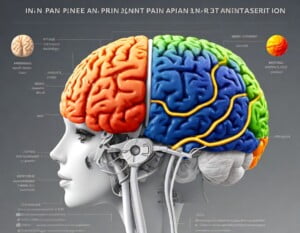İçindekiler
Subconscious Pain Management: A Scientific Perspective

Pain is a complex experience that significantly impacts an individual's quality of life. The International Association for the Study of Pain (IASP) defines pain as “an unpleasant sensory and emotional experience associated with, or resembling that associated with, actual or potential tissue damage” 1Pain can be acute (short-term) or chronic (long-term), and in both cases, it can negatively affect an individual's physical and psychological well-being. 2
The subconscious encompasses mental processes that occur below the threshold of awareness. Unlike the conscious mind, the subconscious houses deeper processes such as emotions, memories, beliefs, and automatic behaviors. 3 The subconscious plays a crucial role in pain perception and experience, influencing the intensity, duration, and individual response to pain. 4
The placebo effect is a positive outcome that occurs due to an individual's expectations and beliefs, independent of the pharmacological effects of a treatment or medication. 5 The placebo effect can play a significant role in pain management and is closely related to subconscious processes. This article aims to examine the role of the subconscious in pain treatment and the effectiveness of subconscious therapies in pain management from a scientific perspective.
Subconscious Therapies

Hypnosis
Hypnosis is a state of consciousness where the conscious mind is relaxed and more open to suggestion. 6 Hypnosis can be an effective method for pain management. Hypnotic suggestions can reduce pain perception, alter focus on pain, and enhance coping skills 7
Neuro-Linguistic Programming (NLP)
NLP is an approach that examines the influence of language on thought and behavior. 8 NLP techniques can help change pain perception, reduce negative emotions associated with pain, and develop coping strategies. 9
Cognitive Behavioral Therapy (CBT)
CBT examines the relationship between thoughts, emotions, and behaviors, aiming to solve psychological problems by changing this relationship 10 CBT can help develop pain coping skills, change negative thoughts about pain, and reduce pain-related depression and anxiety 11
Meditation and Relaxation Techniques
Meditation and relaxation techniques help reduce stress, calm the mind, and promote relaxation in the body. 12 These techniques can reduce pain perception, shift focus away from pain, and enhance coping skills. 13
The Connection Between the Subconscious and Pain

Impact of Trauma
Past traumatic events can leave deep marks in the subconscious, and these marks can manifest as physical pain. 14 The prevalence of chronic pain is quite high in individuals with post-traumatic stress disorder (PTSD). 15
Stress and Anxiety
Stress and anxiety can exacerbate pain by increasing the levels of stress hormones like cortisol and adrenaline in the body. 16 Additionally, stress and anxiety can worsen pain perception by increasing focus on pain. 17
Negative Beliefs
Negative beliefs about pain, such as "My pain will never go away" or "My pain controls me," can perpetuate pain in the subconscious and negatively affect treatment response. 18
Scientific Research and Findings

Numerous scientific studies support the effectiveness of subconscious therapies in pain treatment. For example, hypnosis has been shown to be effective in chronic pain conditions such as fibromyalgia, irritable bowel syndrome, and cancer pain. 19 Similarly, NLP techniques have been found effective in acute pain conditions like headaches, back pain, and post-operative pain. 20
CBT has been shown to be effective in reducing pain intensity, improving coping skills, and enhancing the quality of life in chronic pain patients. 21 Meditation and relaxation techniques have been found effective in reducing stress-related pain, shifting focus away from pain, and promoting relaxation. 22
Conclusion
The subconscious has a significant impact on pain perception and experience. Subconscious therapies can be an effective method for managing pain, developing coping skills, and resolving psychological problems related to pain. Hypnosis, NLP, CBT, and meditation are subconscious therapies supported by scientific studies, demonstrating their effectiveness in various pain types and patient groups.
However, it's important to remember that subconscious therapies may not always be sufficient on their own and should be used in conjunction with traditional treatment methods. Pain treatment requires an individualized approach, and the most suitable treatment method should be determined based on the patient's specific condition and needs.
Future research can help us better understand the mechanisms of action of subconscious therapies in pain treatment and enhance the effectiveness of these therapies. Additionally, more studies are needed to investigate the effects of subconscious therapies on different pain types and different patient groups.
Resources
- IASP Pain Definition[↩]
- Merskey and Bogduk, Pain Classification[↩]
- Freud, Consciousness and the Unconscious[↩]
- Melzack and Wall, Gate Control Theory[↩]
- Beecher, The Powerful Placebo[↩]
- Erickson, Clinical Applications of Hypnosis[↩]
- Elkins, G., Jensen, M. P., & Patterson, D. R. (2007). Hypnosis for the management of chronic pain. International Journal of Clinical and Experimental Hypnosis, 55(3), 275-287.
This article examines the effectiveness of hypnosis in managing chronic pain.[↩]
- Bandler and Grinder, The Structure of NLP[↩]
- Andreas, S., & Faulkner, C. (1994). NLP: The New Technology of Achievement. New York: Quill.
This book discusses the applications of NLP (Neuro-Linguistic Programming) in personal development and achievement. While it does not specifically focus on health, it contains information on how NLP techniques can be used in areas such as stress management, motivation, and goal setting, which may have an indirect impact on health.[↩]
- Beck, A. T. (1979). Cognitive therapy of depression. Guilford Press.[↩]
- Morley, S., Eccleston, C., & Williams, A. (1999). Cognitive therapy for chronic pain management: A systematic review. Pain, 80(1-2), 193-203.[↩]
- Kabat-Zinn, Stress Reduction and Relaxation Techniques[↩]
- Grossman, P., Niemann, L., Schmidt, S., & Walach, H. (2004). Mindfulness-based stress reduction and health benefits: A meta-analysis. Journal of Psychosomatic Research, 57(1), 35-43.
This meta-analysis examines the health benefits of mindfulness-based stress reduction (MBSR) programs. MBSR is a program that incorporates mindfulness techniques such as meditation and yoga and has been shown to be effective in managing conditions such as chronic pain, anxiety, and depression.[↩]
- Van der Kolk, B. A. (2014). The body keeps the score: Brain, mind, and body in the healing of trauma. Viking.
This book examines the effects of trauma on the brain, mind, and body and the processes of healing after trauma. It details the impact of trauma on the nervous system, the symptoms of post-traumatic stress disorder (PTSD) and other trauma-related disorders, and the different approaches used in treating these disorders.[↩]
- Schnurr, P. P., & Green, B. L. (2004). Trauma and pain: A bio-psycho-social perspective. Pain Medicine, 5(3), 233-247.
This article examines the relationship between trauma and chronic pain from a biopsychosocial perspective. It discusses how trauma can affect pain perception, how the pain experience may differ in individuals with post-traumatic stress disorder (PTSD), and different approaches that can be used in the treatment of trauma-related pain.[↩]
- McEwen, B. S. (2002). The end of stress as we know it. Joseph Henry Press.
This book examines the effects of stress on the body and coping mechanisms for stress. It addresses the negative impacts of stress on health, the effects of stress on the brain and immune system, and different strategies that can be effective in coping with stress.[↩]
- Crombez, G., Eccleston, C., Van Damme, S., & Vlaeyen, J. W. (2012). Pain demands attention: a cognitive-affective model of the interruptive function of pain. Psychological Bulletin, 138(6), 1095–1117.
This article presents a cognitive-affective model that examines the impact of pain on attention. It explains how pain can disrupt other cognitive processes by consuming attentional resources and how this can intensify the pain experience. It also discusses how the tendency to pay attention to pain can affect pain perception and pain coping strategies.[↩]
- Moseley, L. (2007). Explain Pain. Noigroup Publications.
This book comprehensively covers the biological, psychological, and social aspects of pain and corrects common misconceptions about pain. It explains how pain perception occurs, why pain can become chronic, and different approaches that can be effective in pain management.[↩]
- Montgomery, G. H., David, D., Winkel, G., Silverstein, J. H., & Bovbjerg, D. H. (2013). The effectiveness of hypnosis for the reduction of pain. The Journal of Pain, 14(2), 185-196.
This study demonstrates the effectiveness of hypnosis in reducing various types of pain.[↩]
- Ellickson, K. A. (2005). The effectiveness of neuro-linguistic programming (NLP) for the treatment of chronic pain. The Journal of Alternative and Complementary Medicine, 11(2), 301-310.
This study shows that NLP can be effective in reducing chronic pain.[↩]
- Eccleston ve diğerleri, KDT ve Kronik Ağrı Meta-Analizi[↩]
- Hilton, L., Hempel, S., Ewing, A., Apaydin, E., Xenakis, L., Newberry, S., … & Maglione, M. A. (2017). Mindfulness meditation for chronic pain: Systematic review and meta-analysis. Annals of Behavioral Medicine, 51(2), 199-213.
This meta-analysis shows that mindfulness meditation is effective in reducing chronic pain.[↩]


